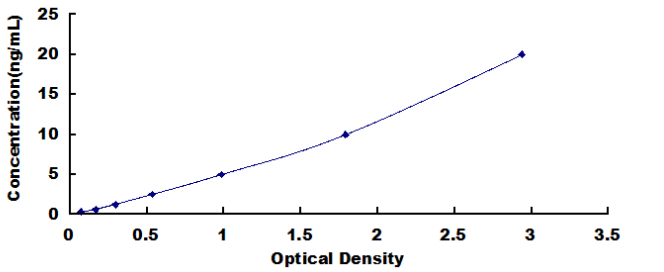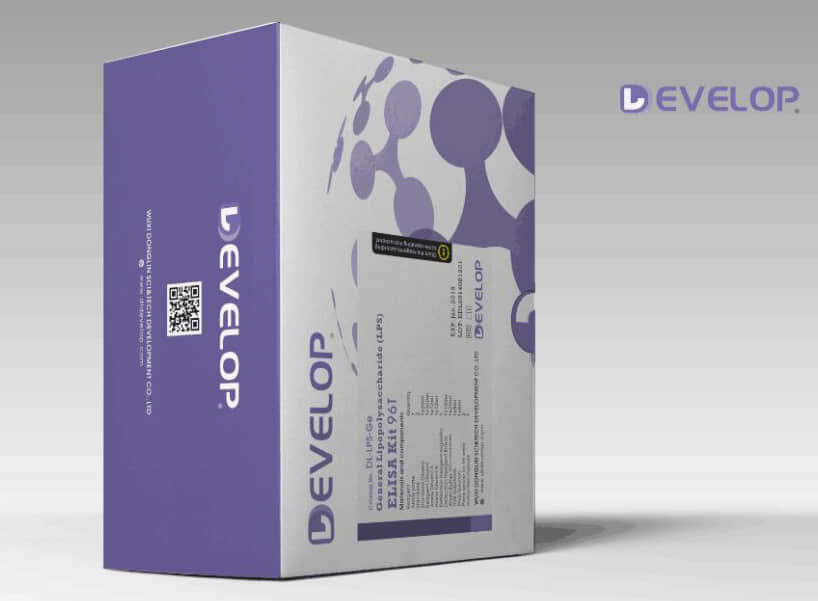Human ATP Binding Cassette Transporter C8 (ABCC8) ELISA Kit


two product lines: Traditional ELISA Kit and Ready-to-Use ELISA Kit.


Other names:ABC-C8; PHHI; MRP8; ABC36; HHF1; HI; HRINS; SUR; SUR1; TNDM2; Sulfonylurea Receptor(Hyperinsulinemia)
Function: Putative subunit of the beta-cell ATP-sensitive potassium channel (KATP). Regulator of ATP-sensitive K(+) channels and insulin release.
Sequence:
MPLAFCGSEN HSAAYRVDQG VLNNGCFVDA LNVVPHVFLL FITFPILFIG
WGSQSSKVHI HHSTWLHFPG HNLRWILTFM LLFVLVCEIA EGILSDGVTE
SHHLHLYMPA GMAFMAAVTS VVYYHNIETS NFPKLLIALL VYWTLAFITK
TIKFVKFLDH AIGFSQLRFC LTGLLVILYG MLLLVEVNVI RVRRYIFFKT
PREVKPPEDL QDLGVRFLQP FVNLLSKGTY WWMNAFIKTA HKKPIDLRAI
GKLPIAMRAL TNYQRLCEAF DAQVRKDIQG TQGARAIWQA LSHAFGRRLV
LSSTFRILAD LLGFAGPLCI FGIVDHLGKE NDVFQPKTQF LGVYFVSSQE
FLANAYVLAV LLFLALLLQR TFLQASYYVA IETGINLRGA IQTKIYNKIM
HLSTSNLSMG EMTAGQICNL VAIDTNQLMW FFFLCPNLWA MPVQIIVGVI
LLYYILGVSA LIGAAVIILL APVQYFVATK LSQAQRSTLE YSNERLKQTN
EMLRGIKLLK LYAWENIFRT RVETTRRKEM TSLRAFAIYT SISIFMNTAI
PIAAVLITFV GHVSFFKEAD FSPSVAFASL SLFHILVTPL FLLSSVVRST
VKALVSVQKL SEFLSSAEIR EEQCAPHEPT PQGPASKYQA VPLRVVNRKR
PAREDCRGLT GPLQSLVPSA DGDADNCCVQ IMGGYFTWTP DGIPTLSNIT
IRIPRGQLTM IVGQVGCGKS SLLLAALGEM QKVSGAVFWS SLPDSEIGED
PSPERETATD LDIRKRGPVA YASQKPWLLN ATVEENIIFE SPFNKQRYKM
VIEACSLQPD IDILPHGDQT QIGERGINLS GGQRQRISVA RALYQHANVV
FLDDPFSALD IHLSDHLMQA GILELLRDDK RTVVLVTHKL QYLPHADWII
AMKDGTIQRE GTLKDFQRSE CQLFEHWKTL MNRQDQELEK ETVTERKATE
PPQGLSRAMS SRDGLLQDEE EEEEEAAESE EDDNLSSMLH QRAEIPWRAC
AKYLSSAGIL LLSLLVFSQL LKHMVLVAID YWLAKWTDSA LTLTPAARNC
SLSQECTLDQ TVYAMVFTVL CSLGIVLCLV TSVTVEWTGL KVAKRLHRSL
LNRIILAPMR FFETTPLGSI LNRFSSDCNT IDQHIPSTLE CLSRSTLLCV
SALAVISYVT PVFLVALLPL AIVCYFIQKY FRVASRDLQQ LDDTTQLPLL
SHFAETVEGL TTIRAFRYEA RFQQKLLEYT DSNNIASLFL TAANRWLEVR
MEYIGACVVL IAAVTSISNS LHRELSAGLV GLGLTYALMV SNYLNWMVRN
LADMELQLGA VKRIHGLLKT EAESYEGLLA PSLIPKNWPD QGKIQIQNLS
VRYDSSLKPV LKHVNALIAP GQKIGICGRT GSGKSSFSLA FFRMVDTFEG
HIIIDGIDIA KLPLHTLRSR LSIILQDPVL FSGTIRFNLD PERKCSDSTL
WEALEIAQLK LVVKALPGGL DAIITEGGEN FSQGQRQLFC LARAFVRKTS
IFIMDEATAS IDMATENILQ KVVMTAFADR TVVTIAHRVH TILSADLVIV
LKRGAILEFD KPEKLLSRKD SVFASFVRAD K
2. Features
INTENDED USE
The kit is a sandwich enzyme immunoassay for the in vitro quantitative measurement of ABCC8 in human tissue homogenates, cell lysates and other biological fluids.
DETECTION RANGE
0.312-20ng/mL. The standard curve concentrations used for the ELISA’s were 20ng/mL, 10ng/mL, 5ng/mL, 2.5ng/mL, 1.25ng/mL, 0.625ng/mL, 0.312ng/mL.
SENSITIVITY
The minimum detectable dose of ABCC8 is typically less than 0.128ng/mL.
The sensitivity of this assay, or Lower Limit of Detection (LLD) was defined as the lowest protein concentration that could be differentiated from zero. It was determined by adding two standard deviations to the mean optical density value of twenty zero standard replicates and calculating the corresponding concentration.
SPECIFICITY
This assay has high sensitivity and excellent specificity for detection of ABCC8.
No significant cross-reactivity or interference between ABCC8 and analogues was observed.
Note: Limited by current skills and knowledge, it is impossible to perform all possible cross-reactivity detection tests between ABCC8 and all analogues, therefore, cross reactivity may still exist.
IMPORTANT NOTES
1. Limited by the current conditions and scientific technology, it is impossible to conduct comprehensive identification and analysis tests on the raw materials provided by suppliers. As a result, it is possible there are some qualitative and/or technical risks.
2. The final experimental results will be closely related to the validity of the products, operation skills of the end users and the experimental environments. Please make sure that sufficient samples are available to obtain accurate results.
3. Kits from different batches may be a little different in detection range, sensitivity and color developing time. Please perform the experiment exactly according to the instruction manual included in your kit. Electronic ones on our website are for reference only.
4. Do not mix or substitute reagents from one kit lot to another. Use only the reagents supplied by manufacturer.
5. Protect all reagents from strong light during storage and incubation. All bottle caps of reagents should be closed tightly to prevent evaporation of liquids and contamination by microorganisms.
6. There may be a foggy substance in the wells when the plate is opened at the first time. It will not have any effect on the final assay results. Do not remove microtiter plate from the storage bag until needed.
7. Incorrect procedures during reagent preparation and loading, as well as incorrect parameter setting for the plate reader may lead to incorrect results. A microplate plate reader with a bandwidth of 10nm or less and an optical density range of 0-3 O.D. or greater at 450 ± 10nm wavelength is acceptable for use in absorbance measurement. Please read the instruction carefully and adjust the instrument prior to the experiment.
8. Even the same experimenter may get different results from two separate experiments. In order to get better reproducible results, the operation of every step in the assay should be controlled. Furthermore, a preliminary experiment before the general assay for each batch is recommended.
9. Each kit has undergone several rigorous quality control tests. However, results from end users might be inconsistent with our in-house data due to some unexpected transportation conditions or different lab equipment. Intra-assay variance among kits from different batches could arise from the above factors as well.
10. Kits from different manufacturers with the same item might produce different results, since we have not compared our products with other manufacturers.
11. The standard of the kit and immunogen used for antibody preparation are commonly recombinant proteins. Different expressed sequence, expression systems, purification methods might be used in recombinant protein preparation. Besides, there might exist differences on the screening technique of antibody and antibody pairs in our kit. Thus we can not guarantee the kit could detect recombinant protein from other companies. So, it is not recommended to use the kit for the detection of recombinant protein.
12. Validity period: 12 months.
13. The instruction manual also works with the 48T kit, but all reagents in the 48T kit are reduced by half.
You can reference link of the kit as following
https://www.dldevelop.com/uploadfile/data/DL-ABCC8-Hu.pdf
Introduction
| Item | Standard | Test | |
| Description |
The kit is a sandwich enzyme immunoassay for the in vitro quantitative measurement of ABCC8 in human tissue homogenates, cell lysates or other biological fluids. |
Conform | |
| Identification | Colorimetric | Positive | |
| Composition | Traditional ELISA Kit | Ready-to-Use ELISA KIT | Conform |
| Pre-coated, ready to use 96-well strip plate 1 | Pre-coated, ready to use 96-well strip plate 1 | ||
| Plate sealer for 96 wells 2 | Plate sealer for 96 wells 2 | ||
| Standard 2 | Standard 2 | ||
| Diluents buffer 1×45mL | Standard Diluent 1×20mL | ||
| Detection Reagent A 1×120μL | Detection Solution A 1×12mL | ||
| Detection Reagent B 1×120μL | Detection Solution B 1×12mL | ||
| TMB Substrate 1×9mL | TMB Substrate 1×9mL | ||
| Stop Solution 1×6mL | Stop Solution 1×6mL | ||
| Wash Buffer (30 × concentrate) 1×20mL | Wash Buffer (30 × concentrate) 1×20mL | ||
| Instruction manual 1 | Instruction manual 1 | ||
Test principle
This assay employs the competitive inhibition enzyme immunoassay technique. A monoclonal antibody specific to the index has been pre-coated onto a microplate. A competitive inhibition reaction is launched between biotin labeled the index and unlabeled the index (Standards or samples) with the pre-coated antibody specific to the index. After incubation the unbound conjugate is washed off. Next, Avidin conjugated to Horseradish Peroxidase (HRP) is added to each microplate well and incubated. The amount of bound HRP conjugate is reverse proportional to the concentration of the index in the sample. After addition of the substrate solution, the intensity of color developed is reverse proportional to the concentration of the index in the sample.
Recovery
Matrices listed below were spiked with certain level of recombinant ABCC8 and the recovery rates were calculated by comparing the measured value to the expected amount of the index in samples.
| Matrix | Recovery range (%) | Average(%) |
| serum(n=5) | 81-93 | 86 |
| EDTA plasma(n=5) | 80-97 | 88 |
| heparin plasma(n=5) | 90-101 | 95 |
Linearity
The linearity of the kit was assayed by testing samples spiked with appropriate concentration of the index and their serial dilutions. The results were demonstrated by the percentage of calculated concentration to the expected.
| Sample | 1:2 | 1:4 | 1:8 | 1:16 |
| serum(n=5) | 82-96% | 83-98% | 81-99% | 93-101% |
| EDTA plasma(n=5) | 88-101% | 86-95% | 90-102% | 80-93% |
| heparin plasma(n=5) | 80-91% | 82-90% | 95-104% | 79-95% |
Precision
Intra-assay Precision (Precision within an assay): 3 samples with low, middle and high level the index were tested 20 times on one plate, respectively.
Inter-assay Precision (Precision between assays): 3 samples with low, middle and high level the index were tested on 3 different plates, 8 replicates in each plate.
CV(%) = SD/meanX100
Intra-Assay: CV<10%
Inter-Assay: CV<12%
Stability
The stability of ELISA kit is determined by the loss rate of activity. The loss rate of this kit is less than 5% within the expiration date under appropriate storage condition.
Note:
To minimize unnecessary influences on the performance, operation procedures and lab conditions, especially room temperature, air humidity, and incubator temperatures should be strictly regulated. It is also strongly suggested that the whole assay is performed by the same experimenter from the beginning to the end.
Assay procedure summary
1. Prepare all reagents, samples and standards;
2. Add 50µL standard or sample to each well.
And then add 50µL prepared Detection Reagent A immediately.
Shake and mix. Incubate 1 hour at 37℃;
3. Aspirate and wash 3 times;
4. Add 100µL prepared Detection Reagent B. Incubate 1 hour at 37℃;
5. Aspirate and wash 5 times;
6. Add 90µL Substrate Solution. Incubate 15-25 minutes at 37℃;
7. Add 50µL Stop Solution. Read at 450 nm immediately.
Order or get a Quote
We will reply you within 24 hours!














